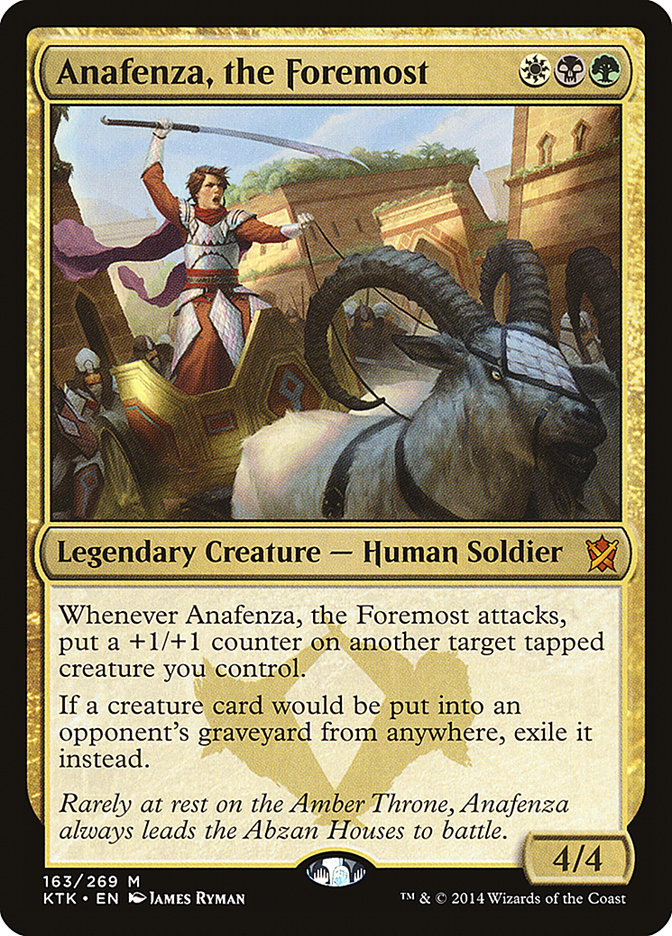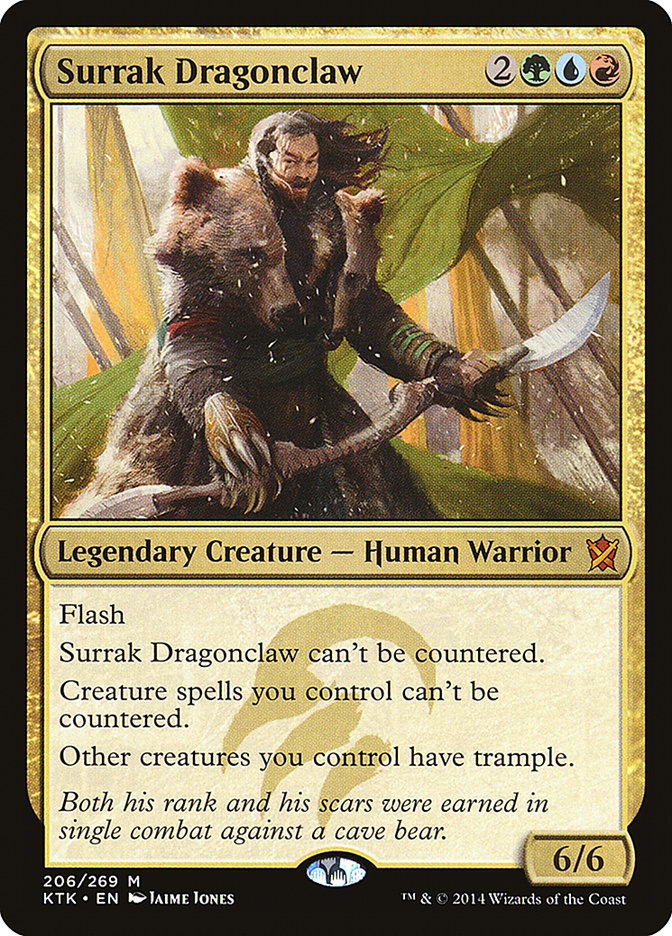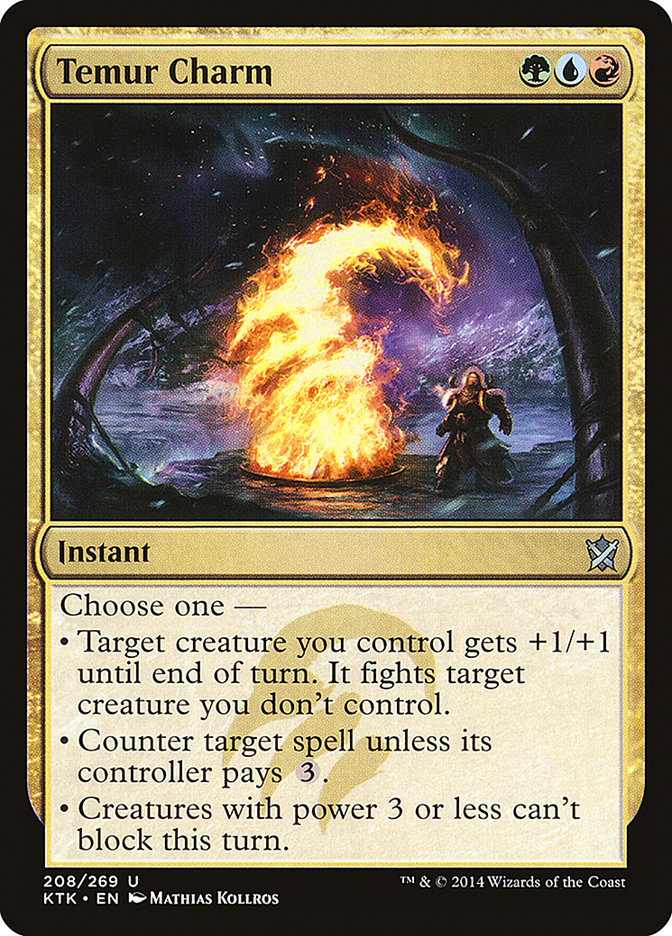Spoilers for Khans of Tarkir have continued to come fast and furious over the last week, with a huge amount of the set revealed already. While there is
still a week to go before we’re going to have the full spoiler in our hands, and another week after that until we’ll get to play with actual cards at the
prerelease, there’s enough information out there that we can start to get a sense of what we’re going to have to work with in Standard after the rotation.
In short – we can actually start thinking about building decks!
It probably comes as no surprise that I’m most excited about Temur and Abzan since I’m a dyed-in-the-wool green mage. That predilection has not changed
since I’ve seen more and more cards get spoiled. Today, I want to take a look at some of the cards that caught my eye and explore some of the possible
decks we might be able to build with them.
Let’s start at the top – the Khans themselves.
There was once a time when a 4/4 creature for three mana without a drawback would immediately get my attention, but that was a long time ago. I mean
seriously – we just went almost an entire year of Standard with Brimaz, King of Oreskos barely seeing play, and he has a much easier casting cost and some
pretty serious upside.
Then again, it’s important to keep in mind that Brimaz spent that year in an environment that was incredibly hostile to creatures of his kind. A three
casting cost mono-white creature? So you’re saying it’s on-curve to get taken by Lifebane Zombie and dies to both Doom Blade and Ultimate Price?
The King of Oreskos could hardly live long enough to rule over any cats, if he even made it into play at all.
It’s a different world now though. Lifebane Zombie is gone (HOORAY!), and along with it are many of the cheap removal spells that kept the good King from
his throne. If we look at Pro Tour Journey into Nyx, we see Brimaz playing a central role in Patrick Chapin’s winning deck – which just so happened to be
Abzan colors.
Anafeza doesn’t dodge Elspeth’s minus ability quite like Brimaz did, but she convincingly wins fights against Courser of Kruphix, which is another card
that is certain to play a big role in the new format. She also encourages you to send your own Coursers into combat against opposing Sylvan Caryatids,
since her +1/+1 counter granting ability can quickly boost your centaurs so they’re big enough to cut through opposing foliage.
Her graveyard hate ability seems almost incidental, but it is certainly something to keep in mind if Sultai decks built around delve become popular. Given
that it only affects creature cards, I don’t expect her to become a real go-to graveyard hate option for Eternal formats. Three mana is far too slow to
stop Dredge decks in Legacy, and the Modern graveyard decks are mostly spell-based, like Storm.
Overall, Anafenza seems solid, but she is not a card I’m necessarily looking to build a deck around in her own right. That could change though, if more
cards that give some kind of payoff for +1/+1 counters are revealed. We’ve already seen Ivorytusk Fortress and Abzan Battle Priest, but neither of those
seem costed quite aggressively enough to make it in Standard.
Now this is a man after my own heart. Surrak combines several of my greatest loves into a single card – big creatures and giving the middle finger to
control players. The combination of flash and uncounterability on Surrak makes him an absolute nightmare for a lot of decks.
Exactly how good Surrak’s ability to shut down opposing counterspells will be depends a great deal on how the format shapes up. If the Block Constructed
Pro Tour was any indication, where even the control decks rarely played more than a copy or two of Dissolve, it might not be terribly important. But what
will certainly be important is his ability to allow you to keep mana open and still threaten to play a major threat.
He seems pretty essential in that regard too, since the theme for the Temur faction is quite literally “dies to Elspeth’s minus ability”. Having a sizable
threat who can come down at the end of your opponent’s turn is pretty important when your entire deck can get wiped out by a single main phase activation
of a planeswalker.
But it isn’t just dodging Elspeth that makes Surrak’s flash ability valuable. The Temur clan has quite a few tricks up their sleeve that make keeping mana
up on your opponent’s turn quite valuable. It is precisely this diversity of options that makes the ability so valuable, because your opponent will have a
lot of trouble figuring out what you actually have.
Are you waiting to play Surrak? Are you looking to unmorph a Sagu Mauler? Are you just keeping up mana to return your Savage Knuckleblade? Or is it all of
them and then some?
And here’s the “then some.” Temur Charm is an incredibly versatile tool for any kind of midrange aggro-control style deck, which is exactly how the clan
seems to be shaping up. Holding up your mana threatening to play Surrak is a lot more effective when you can also use that mana to actually stop your
opponent’s Elspeth from ever hitting the table, which is exactly what the Mana Leak mode on Temur Charm can do. Sure, it isn’t as efficient at stopping
things as other three mana counters like Dissipate or Dissolve, but it makes up for that in flexibility.
Of course, even if you’re playing with Surrak, you’re not always going to draw him, so at some point you’re going to have to play another creature during
your main phase. The problem with countermagic in a creature heavy deck is that you’re constantly faced with the tension of tapping out to play creatures
or holding up mana to counter something your opponent might play, and if something slips through the cracks when you do tap out, your counterspell can’t do
very much about it after the fact. Exceptions to this rule are few and far between, like Cryptic Command, which has proven to be incredibly powerful as a
result.
Temur Charm is no Cryptic Command, but it does offer the ability to stop something from ever hitting the board or remove it once it’s in play, assuming you
have something big enough to fight it with, of course. In my world, I always tend to have the biggest creature on the block, so that’s unlikely to be a
problem for me.
One really important thing to keep in mind when evaluating Temur Charm is that Supreme Verdict is going to be rotating along with Sphinx’s Revelation and
friends. This means countermagic is once again a reasonable way to keep your creatures from dying a horrible death. Simic got the short end of the
proverbial stick, since for their entire time in Standard, they had no good way to protect their evolving armies from getting wiped out by fiat.
Thankfully, our bear punching buddies are going to have a better time of it, and Temur Charm is going to play a major role in protecting their hordes from
getting wiped out by mass removal. And when the Charm isn’t needed for that – they can use it to punch someone, or push all the weaklings out of the way so
they can all punch the opponent!
But Temur doesn’t get all the goods!
If Temur Charm is the perfect collection of abilities for a deck with a bunch of big creatures looking to rumble, Abzan Charm is exactly what a deck
looking to grind an opponent down with value wants. Remember how we were talking about Anafenza before and how she could have fit right in to Patrick
Chapin’s Pro Tour winning deck in Theros Block Constructed? Now this is a card that deck would have loved!
All three modes on Abzan Charm are pretty great. First of all, the exile mode (off a creature with power 3 or greater) offers a solution to the M15 Souls
and their activated abilities from the graveyard, which are much more likely to be relevant in the new Standard now that Sphinx’s Revelation is gone. It
can’t kill Courser of Kruphix, but in a deck that is likely to be playing Courser and Caryatid itself, you’re likely to care much more about the creatures
that are big enough to break through them.
The card draw mode (you lose 2 and draw 2) however, gives the charm the ultimate escape valve – if neither of the other abilities are good, you can just
cash it in for a shot at something better. I actually really disliked the cycling ability on Azorius Charm, since it feels like the whole point of Charms
is to offer a variety of flexible options so one of them is likely to be useful, but this feels a bit different to me since it at least has the life loss
tacked on. Sign in Blood certainly feels a lot different than cycling.
The last ability, distributing two +1/+1 counters on up to two creatures, is easier to evaluate that Anafenza’s similar ability because if nothing else
it’s a potential combat trick. On top of that, there are two things that jump out at me when I think about this ability.
First is the heroic mechanic from Theros Block. I remember Matt Nass playing a G/W Heroic deck at a Standard Open once, and while it never really made a
splash, the deck was certainly capable of some powerful things. He even ran Common Bond, which Abzan Charm can imitate and then some. I don’t think the
Charm alone could put Abzan Heroic on the map, but the departure of so much of the cheap black removal from the format can’t hurt its chances either.
The second thing I thought of was Elspeth. Abzan Charm’s third ability does not say “you control,” so you could actually use it on your opponent’s
creatures in a pinch to bring them in range of Elspeth’s minus ability. It may seem like a corner-case scenario, but given how much we saw Elspeth at the
Pro Tour Journey Into Nyx, it’s not clear that anything involving that card is a corner case.
So let’s try building some decks, shall we?
Let’s start with Temur:
Creatures (24)
- 4 Elvish Mystic
- 3 Polukranos, World Eater
- 2 Sylvan Caryatid
- 2 Stormbreath Dragon
- 4 Rattleclaw Mystic
- 3 Sagu Mauler
- 4 Savage Knuckleblade
- 2 Surrak Dragonclaw
Planeswalkers (6)
Lands (24)
Spells (6)

Now I’m certain the particulars of this deck are wrong, but I just wanted to put together a bunch of the cards that seem like I’d want to try them. The
combination of Elvish Mystic, Rattleclaw Mystic, and Sylvan Caryatid offer a whole lot of mana acceleration. You can churn out big creatures very quickly
and keep your opponent on the back foot with Temur Charm. Polukranos was largely a non-factor in the past year of Standard thanks to its weakness against
both Mono-Black Devotion and U/W Control, but with key cards from both of those strategies rotating, it very well may be the hydra’s time to shine.
In addition to an array of big creatures, there are also a pair of powerful planeswalkers in Xenagos and Sarkhan. Xenagos is a card that impressed me time
and again in testing for the Pro Tour, and despite being a planeswalker I think it was also oppressed by Lifebane Zombie, because the 3/1 intimidate body
made the Satyr easy pickings. There’s no more Lifebane (HOORAY!), but there is Mantis Rider nowadays, who can unfortunately threaten to take out Xenagos
after a single activation. If the bug-riding monk is popular, Xenagos may not be the best, but he’s outrageously powerful if he stays in play for more than
a turn or two, so it’s good that he has some weaknesses.
I’m splitting the difference between Stormbreath Dragon and Sarhkan here, in part because I don’t think either one of them is clearly better, and in part
because I want to make room to try cards like Surrak and Sagu Mauler. If the format turns out to be anything like Block, I think Sagu Mauler is potentially
a strong option to fight back against the midrange black decks with Silence the Believers, so I wanted to give it a shot.
This list doesn’t have Courser of Kruphix, instead focusing on the more aggressive three-drop of Savage Knuckleblade. That may be a mistake, but I think
Courser is better suited to decks trying to play a longer game. Which is what we’re going to look at next!
Creatures (18)
Planeswalkers (6)
Lands (24)
Spells (12)

This is clearly a slower deck, built around grinding the opponent out with removal and value from Courser of Kruphix and the planeswalker package. It’s
pretty clearly based on the shell of Patrick Chapin’s Pro Tour winning deck, but it gains access to new tools like Abzan Charm, Siege Rhino, and Sorin,
Solemn Visitor.
Anafenza takes the place of Brimaz here and is interestingly probably much easier to cast thanks to her three single colored mana cost instead of the
double white of Brimaz. The combination of Anafenza, Siege Rhino, and Fleecemane Lion actually give this deck the ability to present quite the clock, one
that can be backed up by a variety of disruption and removal. And if you reach the midgame and manage to monstrous a Lion, both Anafenza and Abzan Charm
offer the ability to load it up with +1/+1 counters to ensure that it is a serious threat.
The new Sorin doesn’t seem quite as potent as his previous incarnation, but planeswalkers are an easy card type to underestimate. Even if you just use his
-2 ability twice, Sorin can create a pair of 2/2 fliers, which are certainly quite valuable in a world in which the ground is clogged up by Caryatids and
Coursers. If you can manage to keep him around after using his +1 ability twice – which, again, is much easier in a world of Caryatids and Coursers – he
turns into The Abyss, which is a pretty powerful effect.
This is all ignoring the value that you can actually get from his +1 ability. This kind of deck uses its life as a resource, between Thoughtseize and Abzan
Charm. Sorin can help get some of that life back, or even just shut the door on an aggressive deck looking to burn you out. The early events of a new
format always seem to be full of people looking to take advantage of poorly tuned decks by playing something like Mono-Red Aggro. How is Mono-Red ever
supposed to beat a deck full of not only Coursers and Caryatids, but also Siege Rhinos that have Sorin backing them up for even more lifegain?
What Khans cards have you excited to build decks? What clan are you most excited to play?



